Pocket Knife vs. Multi-tool
Physically, it’s easy to see the difference between a pocket knife and a multi-tool. You often see pocket knives with just a single blade while multi-tools have a bunch of tools on top of a knife blade.
What’s the difference between a pocket knife and a multi-tool? The difference between pocket knives and multi-tools can be seen in the construction as well as the number of tools each one contains. Knives usually have a single blade. Multi-tools have one or more blades and usually have pliers and many other tools like saws blades and can openers.
If a multi-tool has a blade and more tools inside of it, then why would you ever choose to go with a pocket knife over a multi-tool? Let’s look at that question a little closer.
[wc_toggle title=”Table of Contents” padding=”” border_width=”” class=”” layout=”box”]
[/wc_toggle]
The Difference Between Pocket Knives and Multi-tools
Pocket knives and multi-tools both have their strengths and weaknesses. In some circumstances, one is clearly better than the other, and in other circumstances, it’s more difficult to choose between the two.
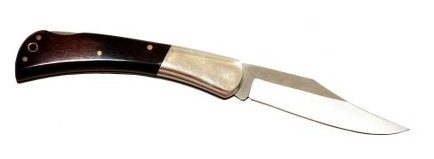
Pocket Knives
The pros and cons of the pocket knife are generalities. There are few absolutes when it comes to gear. If you start getting into things like swiss army knives, you begin to bridge the gap between knives and multi-tools. When this happens some of the pros and cons can be thrown off.
Pros of pocket knives:
- Small enough to carry in a pocket
- Lighter than multi-tools
- The blade is easier to open and use
- The blade typically has a more solid lock up
Cons of pocket knives:
- Lacks the additional tools
With all of these pros, why would you ever choose a multi-tool over a knife? That’s pretty easy to answer. If you need other tools on a regular basis, then you’re better off going with a multi-tool over a knife or carrying both a multi-tool and a knife.
A knife is just more convenient to carry and easier to use than a multi-tool when you’re only cutting things. Once you have to do something that requires a pair of pliers, that knife is pretty much useless…
Parts of a knife
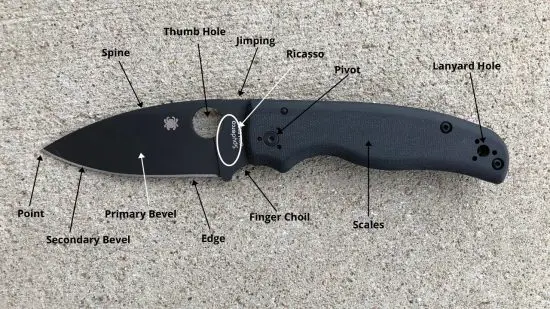
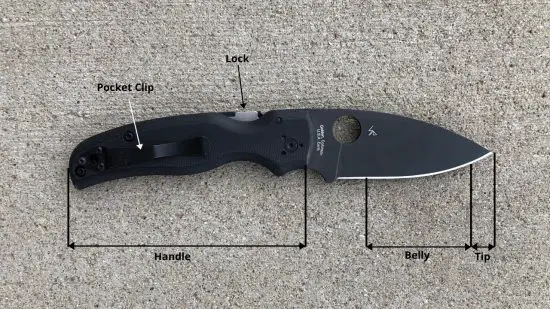
What is the best pocket knife steel?
Right now the best knife steel in my option is S30V. It was specifically designed to be used for making knife blades and has good hardness and corrosion resistance and holds an edge very well.
The only real downside to S30V is that it can be difficult to sharpen once it loses its edge.
Different blade styles and their uses
Blade shape can sometimes make a big difference in how a knife handles and performs. Many blade shapes are designed to try to maximize certain aspects of a knife like its piercing ability or its cutting power. Other designs aim to be well rounded and good at many of the common tasks knife owners would want to accomplish.
In the end, nearly any blade shape can accomplish any common knife task, but certain shapes are better for some tasks. If you find that you do one kind of task over and over with your knives, you may want to choose a blade shape that’s specialized to that task or a blade shape that is a good all-around design but lends itself to accomplishing that one task a little more efficiently. It’s really up to the preference of the person using the knife!

Simple Point Blade – The simple point blade, sometimes called the common point blade, has an edge that curves up to meet the spine of the blade and forms a point roughly in line with the spine of the blade. The simple point lends itself to easy sharpening and is a good all-around blade shape.
Many survival knives use this blade shape because of its ease of sharpening and its overall strength.
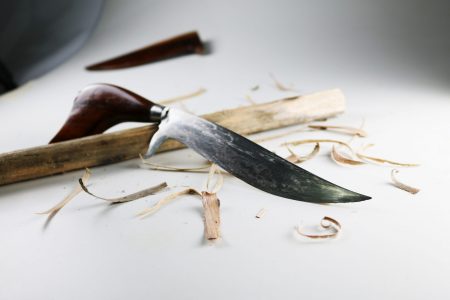
Trailing Point Blade – The trailing point blade has an edge the curves up and meets the spine at a point above the handle. This gives the blade a much larger belly than other blade shapes.
Trailing point blades are most often found in fillet knives and other knives that are intended for cleaning fish and small game.
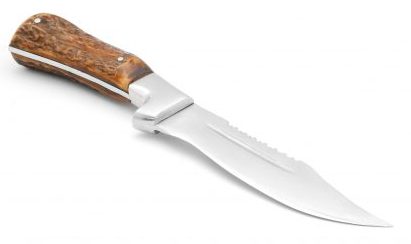
Clip Point Blade – The clip point blade gets its name from the fact that it looks like it is a simple point blade that has had a section of it “clipped” out. This makes the point of the blade much finer than the point of a simple point blade. The tip of a clip point blade is still usually in line with the spine of the blade.
You’ll usually see this type of blade shape in Bowie knives and other knives designed for piercing a target.
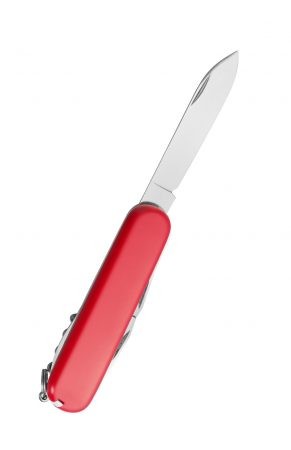
Drop Point Blades – The drop point blade has a spine that drops down toward the edge to form the tip. It’s probably the most common style of knife blade due to its strong tip and a design that lends itself to a wide range of common knife tasks. It’s good at piercing and cutting.
The iconic shape of the Swiss army knife is a drop point blade.
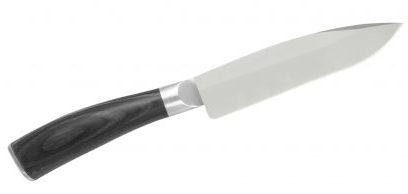
Spear Point Blade – Spear point blades adopt the shape of a spearhead. This means that the point is symmetrical on both sides with the tip in line with the center axis of the handle. Sometimes both edges are sharpened and other times only one side will be sharp.
Spear point blades are usually designed for piercing or stabbing and are commonly found on daggers or other fighting knives.
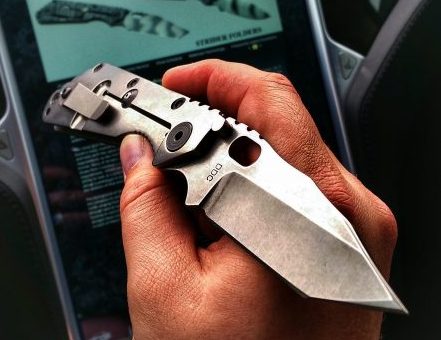
Needle Point Blade – Needle point blades take the spear point design and further improve it to make a tip that is very narrow to make them great piercers. The tip is usually in line with the center axis of the knife to allow for as much piercing power as possible.
Needle point knives usually sacrifice a lot of cutting ability compared to other blades styles.
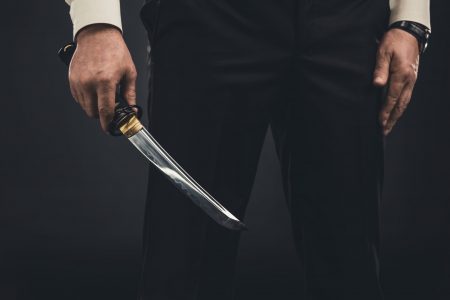
Tanto Blade – Tanto blades use the traditional Japanese style blade shape to make form a strong piercing tip. The way that the spine tapers into the tip makes it very narrow while retaining its strength.
A lof of EDC knives are adopting the tanto blade. This is more due to the look of the blade rather than any actual functional use in my opinion. Tanto blades tend to be difficult to sharpen and aren’t especially good for day to day tasks.
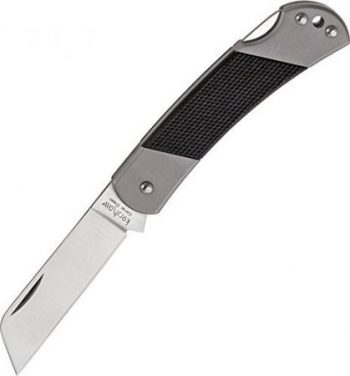
Sheepsfoot Blade – The sheepsfoot blade has a spine that drops down to meet the edge of the blade. The blade edge is usually completely straight or only has a slight bow in it. This style of blade was designed to trim the hooves of sheep and not accidentally ab the sheep if they pulled away or moved suddenly.
You’ll also find this style of blade on a lot of knives designed for use by sailors so they can do common tasks like cutting rope while not running the risk of stabbing themselves.
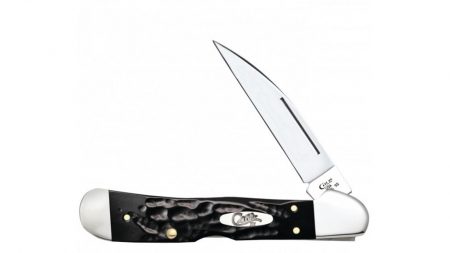
Wharncliffe Blade – The wharncliffe blade is similar to a sheepshoof blade except the spine of the blade gradually tapers down to the edge of the blade starting at the handle of the knife. It was designed for sailors so they don’t accidentally stab themselves on the rolling decks of a ship.
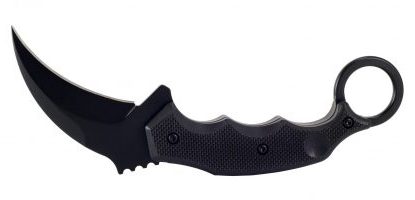
Hawkbill Blade – The hawkbill blade is essentially a reverse trailing point blade. The edge of the blade curves down and the spine of the blade curves down to meet it forming a tip that is below the handle of the knife.
Hawkbill blades are common on knives designed to make long, straight cuts in things like carpet and are also popular in some styles of fighting knives.
This isn’t an all-inclusive list of blade shapes that you’ll find out there. It’s just the most common types of blade designs that you’ll probably run into or have a use for on a daily basis.
What pocket knife holds the best edge?
A lot of people are looking for a maintenance-free knife that holds an edge for as long as possible, but they often overlook the obvious answer…it’s about the type of steel the blade is made out of, not the particular knife itself.
You can actually find some manufacturers that will sell a knife for a long time and mid-way through the life of the product, they will change the type of steel that the blade is made of. This can completely change the way the knife cuts and how long it keeps an edge. Always look at the steel, not necessarily the manufacturer or even the specific model!
What does open carrying a knife mean?
Open carrying a knife is when you carry it so that it isn’t hidden, it’s not in a pocket or inside a bag, it’s there and plainly obvious that you’re carrying a knife. Don’t think that a knife with a pocket clip and the backside of the handle exposed isn’t concealed…it is.
This doesn’t come up a whole lot with knives honestly. Normally open carrying and concealed carrying are discussions that are reserved for firearms, but it comes up enough that I wanted to touch on it here.
Can I bring a small pocket knife on a plane?
TSA doesn’t allow any knife of any size on planes so don’t bother trying to take one in your carry on. If you need a knife once you land, pack it in your checked bag.
Can you bring a pocket knife on a cruise?
If you’re looking to carry a knife on a cruise, you should check with the cruise line before you take it with you. Some cruise lines like Carnival allow you to take a knife on board while others don’t let you take one.
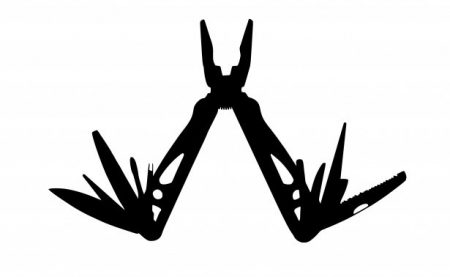
Multi-Tools
Multi-tools are an attempt to jam as many common tools into one tool as possible. You normally get multiple blades, pliers, screwdrivers, files, saws, and sometimes a lot more, but they have some drawbacks compared to just carrying a pocket knife.
Pros of multi-tools:
- Wide range of tools in one small package
Cons of multi-tools:
- More difficult to carry around every day than a pocket knife
- Weighs more than most people like to carry around
- Too big to comfortably put in a pocket
- Each tool is usually less effective than a dedicated tool would be
Multi-tools seem to lose to knives in just about every way when you compare the pros and cons of each. The truth is a knife is very good at cutting and is usually going to do a better job than a multi-tool when you just need to cut something.
Once you start to do other things that don’t just require cutting a multi-tool really begins to shine. At that point, all the ease of carrying that you get from a knife doesn’t matter if it can’t take care of the job that you need to get done!
What are the tools on a multi-tool?
Multi-tools are all different so you’re not going to get the same tools on each one.
The list below provides an idea of the types of tools that you can expect to find on most multi-tools:
- Pliers
- Wire Cutters
- Straight Bladed Knife
- Serrated Bladed Knife
- Saw
- Scissors
- Ruler
- Can Opener
- Bottle Opener
- Files
- Screwdrivers
What is the best multi-tool?
Right now, I think the best multi-tool is the Leatherman Wave Plus. It’s got all of the best features of the Leatherman Wave and now it has stronger wire cutters that are replaceable.
I really wish they would make a multi-tool with pliers that can be replaced. That’s really the only thing I ever break on my multi-tools.
Can you bring a multi-tool on a plane?
TSA doesn’t allow any tools with blades in carry-on bags or in passenger’s pockets. If you need a multi-tool when you get to your destination, then you should put it in your checked bag.
Are you allowed to bring a multi-tool on a cruise?
Multi-tools may or may not be allowed on cruises depending on which cruise line you’re traveling with. Some will allow you to take tools with blades up to about 4 inches and others just flat out prohibit all knives.
Make sure you check with the cruise line before you try to take a multi-tool on a cruise with you. If you show up and try to board the boat where knives aren’t allowed, you’re probably going to lose the knife.
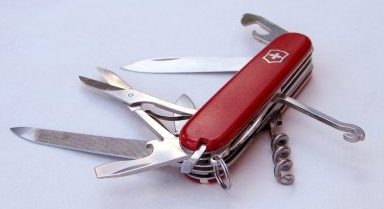
Knives and Multi-tools That Close the Gap Between the Two
Of course, we’re not limited to just choosing a pocket knife or a multi-tool. There are a ton of great knives out there that bridge the gap between pocket knives and multi-tools!
The Leatherman Free T2 and K4, and the Victorinox Swiss Army Hunter are all great options if you’re tempted to go this route. If you like Swiss Army knives, don’t limit yourself to just looking at the Hunter. I only chose that as an example of some of the great knives they’re making these days.
The big drawback is you don’t get pliers with any of these knives, and the pliers are arguably the best part of a multi-tool.
Is a Pocket Knife or Multi-tool Better for EDC?
Choosing between a pocket knife and a multi-tool for EDC really depends on what you do on a day to day basis. If you’re in an office all day then what’s socially acceptable and needed every day is different than if you live and work on a farm.
For this reason, there isn’t ever a cut and dry answer to questions like this.
If you normally find yourself in an office, working on a computer or doing other office tasks, then I would suggest leaning toward choosing a pocket knife as your EDC.
This doesn’t mean that you need to choose a tiny little knife! I’d still choose a knife with a blade that’s between 3 and 4 inches long, but with a design that’s more acceptable to the types of people that usually work in office environments. I’d go for a knife that doesn’t look tactical but is still functional like the Kershaw Leek with a steel handle.
Anyone working outside or in more rural areas has a much larger selection of knives and multi-tools to choose from. In fact, I normally carry a knife and multi-tool if I’m going to working outside for any length of time.
Something like a Spyderco Tenacious paired with a Leatherman Wave Plus would be great for just about anybody that spends time working outside or on the farm.
Conclusion
Choosing between a multi-tool and a knife is really a personal choice. If you’re looking for ease of carrying, light weight, and don’t often need tools other than a cutting blade, then a knife is the obvious tool for you. If you often need tools other than a blade or just want to have more options available to you then you should go with a multi-tool.
Of course, you can always go for the best of both worlds and carry a knife and a multi-tool.
The article Pocket Knife vs. Multi-tool: Which is Better for You? was originally published on: Ready Lifestyle Blog